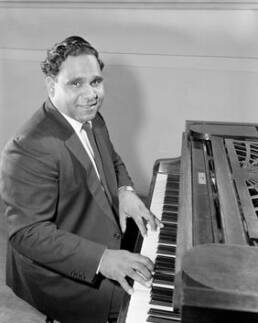These stories may contain descriptions of childhood trauma and abuse. Aboriginal and Torres Strait Islander people should be aware that this website may contain images, voices or names of people who may have passed away. If you need help, you can find contact details for some relevant services on our support page.
Aboriginal Australian opera singer and activist, Harold Blair (1924-1976), grew up in the care of the Salvation Army.
Harold Blair was born at Cherbourg Aboriginal Settlement in Queensland to fourteen year old Esther Quinn. Six months later the pair were transferred to Purga Mission, near Ipswich, also in Queensland.
Harold was separated from his mother at the age of two when she was sent out to work as a domestic servant. The boy was then cared for by Salvation Army staff.
Harold was almost sixteen before he left Purga. He had only a limited education as he was expected to become a labourer. In 1942 he was sent to work in the canefields of Childers in the Bundaberg Region of Queensland during WWII.
Harold had been singing and entertaining at Purga and he continued this while working in the canefields. In 1944 he auditioned for soprano Marjorie Lawrence (1907-1979) and was encouraged to “take his singing more seriously” (Duncan).
In March 1945 he sang on radio in ‘Australia’s Amateur Hour’ and gained a record number of votes. With the help of friends, he sought enrolment at the conservatorium in Sydney and at the university conservatorium in Melbourne, but was rejected because of his limited education. Finally accepted by the Melbourne (Melba) Conservatorium of Music, Albert Street, East Melbourne, Blair worked hard to improve his education, learn foreign languages and master the fundamentals of music. In 1949 he gained a diploma of music (Duncan).
That same year, Harold married a white woman, Dorothy Eden, to considerable public backlash. Shortly after his wedding, Harold left for the United States to study singing at the prestigious Julliard School in New York. He worked a cleaning job to support himself and performed at an Australian Society of New York concern in 1951.
Back in Australia, Blair studied part time and worked in a Melbourne department store until in 1956 he was teaching part-time at the Albert Street conservatorium. He travelled to Europe three years later and did a range of jobs in Australia to support his family while continuing to sing.
In 1967 Blair became a music teacher in the Victorian Department of Education. He performed in the first opera put on at the new Sydney Opera House in 1973 and was appointed a Member of the Order of Australia in 1976.
Harold Blair took on projects to improve the situation for Aboriginal Australians. One of these was the Aboriginal Children’s Holiday Project, which provided holidays in Melbourne for 3000 children living on Queensland missions.
A member (1957-59) of the Aborigines’ Welfare Board in Victoria, Blair also became involved in the Aborigines Advancement League, the Federal Council for the Advancement of Aborigines and Torres Strait Islanders, and the Commonwealth Aboriginal Arts Board (Duncan).
The federal electorate of Blair in Queensland is named in honour of Harold Blair.
References:
O’Neill, Cate. “Cherbourg Aboriginal Settlement (c. 1904 – 1986).” Find & Connect, 2018. https://www.findandconnect.gov.au/ref/qld/biogs/QE01069b.htm
Duncan, Alan. “Blair, Harold (1924-1976).” Australian Dictionary of Biography, vol. 13 (1993). https://adb.anu.edu.au/biography/blair-harold-9520
“Industrial School, Purga Mission Station (1937 – 1948).” Find & Connect, 2018. https://www.findandconnect.gov.au/guide/qld/QE00095
Wyld, Karen. “The fascinating life of Aboriginal opera singer Harold Blair.” NITV, 26 March 2019. https://www.sbs.com.au/nitv/article/2019/03/25/fascinating-life-aboriginal-opera-singer-harold-blair-1
Image available here
